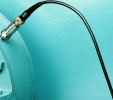Bearing condition monitoring - Part 4
September 2006
Maintenance, Test & Measurement, Calibration

In Part 2 of the Condition Monitoring series of articles, we looked at the development of the shock pulse method and how it measures bearing damage. In Part 3, we looked at the other capabilities of the shock pulse method. Now we will look at how it is possible to measure at these extremely low amplitude levels.
The secret of true shock pulse lies in the transducer. Many have tried and failed to imitate this method using standard vibration transducers. Why is this and why is true SPM so special?
When trying to measure at these low amplitudes one is faced with the relatively high vibration amplitude levels in the lower frequency ranges (below 27 kHz). These mask the shocks and make it difficult to separate them from normal noise generated in the machine. By designing a special transducer that is only sensitive to these high frequency shocks (above 27 kHz) will help. But at these high frequencies the shock amplitudes are also smaller.
How does one get an amplified response from something? When one excites it at its natural frequency. Now that we know this, how do we design this? By defining a specific material mass whose natural frequency is 32 kHz (above 27 kHz where the 'normal mechanical vibration' is dampened out completely). Place this mass on a piezo-electric crystal and connect it to a measuring instrument. That was relatively easy. Now we come to the part on how to distinguish between the low amplitude continuous shocks and erratic high amplitude. This is achieved by using a filter that records the maximum amplitude of the shocks that appear at a frequency rate of higher than 200 Hz. This is determined by looking at 5 ms frames measured over a time span of 2 seconds.
The maximum of the continuous shocks is captured and given the designation dBc or what we call carpet value. The other filter captures the maximum amplitude that has an occurrence frequency of less than 40 Hz. This value is given the designation of dBm or maximum value. Together these two values describe the operating (dBm) and lubrication (dBc) condition of the bearing. Why do we describe the shock amplitudes in decibel? Well, the easy answer is that we are measuring in the ultrasonic range, in other words sound, which is measured in decibel. However, the real reason is that we are using the calibrated response of a transducer's natural frequency. In order to cater for the extremes of the response we have to look at logarithmic scales and instead of developing their own unit of measure, the decibel scale was chosen.
This is all fine and well, but how does this method work in practice? Well actually very well. Next time we look at some real life examples.
Further reading:
New frequency counter with 10 digits of resolution
Comtest
Maintenance, Test & Measurement, Calibration
B&K Precisio has a new series of universal frequency counters designed for a wide range of frequency measurement applications.
Read more...
Verification using Heartbeat Technology is a breeze
Maintenance, Test & Measurement, Calibration
Heartbeat Technology reflects Endress+Hauser’s long-term commitment to enhancing measurement reliability and efficiency across a growing product portfolio.
Read more...
Clog-resistant nozzle for powerful stationary tank cleaning
Maintenance, Test & Measurement, Calibration
As EXAIR and BETE continue to build on a strong partnership, EXAIR has recently added a selection of BETE products to the site, including the innovative BETE HydroClaw tank and vessel cleaning nozzle.
Read more...
Clog-resistant nozzle for powerful
Maintenance, Test & Measurement, Calibration
As EXAIR and BETE continue to build on a strong partnership, EXAIR has recently added a selection of BETE products to the site, including the innovative BETE HydroClaw tank and vessel cleaning nozzle.
Read more...
Why your next oscilloscope should
Comtest
Maintenance, Test & Measurement, Calibration
The PC-based USB oscilloscope is a cutting-edge, adaptable alternative to traditional benchtop oscilloscopes that’s redefining test and measurement.
Read more...
Automated test and measurement
Comtest
Maintenance, Test & Measurement, Calibration
Comtest, in partnership with global brands, provides customised solutions with integrated hardware and software for efficient testing and data collection.
Read more...
Advanced field calibrator and communicator
Maintenance, Test & Measurement, Calibration
The Beamex MC6 is a high-accuracy field calibrator that offers automatic calibration capabilities for pressure, temperature and various electrical signals.
Read more...
Inline particle measurement
Mecosa
Maintenance, Test & Measurement, Calibration
Part of the SOPAT family, Parsum has for more than 20 years stood for the measurement of particles in a running process - without sampling and without a laboratory.
Read more...
Inline analysis measurement technology
Mecosa
Maintenance, Test & Measurement, Calibration
SOPAT develops and sells a photo-optical and image-based inline analysis measurement technology that quantitatively characterises particulate multi-phase systems. The software provides real-time analysis of particle size distribution.
Read more...
UV water treatment system
Maintenance, Test & Measurement, Calibration
bestUV is an innovative manufacturer of professional ultraviolet (UV) water treatment systems for industrial markets.
Read more...


